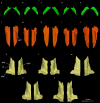Comparative osteology of the hynobiid complex Liua-Protohynobius-Pseudohynobius (Amphibia, Urodela): Ⅰ. Cranial anatomy of Pseudohynobius
- PMID: 32964448
- PMCID: PMC7812138
- DOI: 10.1111/joa.13311
Comparative osteology of the hynobiid complex Liua-Protohynobius-Pseudohynobius (Amphibia, Urodela): Ⅰ. Cranial anatomy of Pseudohynobius
Abstract
Hynobiidae are a clade of salamanders that diverged early within the crown radiation and that retain a considerable number of features plesiomorphic for the group. Their evolutionary history is informed by a fossil record that extends to the Middle Jurassic Bathonian time. Our understanding of the evolution within the total group of Hynobiidae has benefited considerably from recent discoveries of stem hynobiids but is constrained by inadequate anatomical knowledge of some extant forms. Pseudohynobius is a derived hynobiid clade consisting of five to seven extant species living endemic to southwestern China. Although this clade has been recognized for over 37 years, osteological details of these extant hynobiids remain elusive, which undoubtedly has contributed to taxonomic controversies over the hynobiid complex Liua-Protohynobius-Pseudohynobius. Here we provide a bone-by-bone study of the cranium in the five extant species of Pseudohynobius (Ps. flavomaculatus, Ps. guizhouensis, Ps. jinfo, Ps. kuankuoshuiensis and Ps. shuichengensis) based on x-ray computer tomography data for 18 specimens. Our results indicate that the cranium in each of these species has a combination of differences in morphology, proportions and articulation patterns in both dermal and endochondral bones. Our study establishes a range of intraspecific differences that will serve as organizing hypotheses for future studies as more extensive collections of these species become available. Morphological features in the cranium for terrestrial ecological adaptation in Hynobiidae are summarized. Based on the results, we also discuss the evolution and development of several potential synapomorphies of Hynobiidae, including features of the orbitosphenoid and articular.
Keywords: Pseudohynobius; Hynobiidae; cranial osteology; development; evolution; salamander; terrestrial adaptation.
© 2020 Anatomical Society.
Conflict of interest statement
The authors declare there are no competing interests.
Figures















References
-
- AmphibiaTree . (2007) Rhyacotriton variegatus. Digital Morphology. Available at: http://digimorph.org/specimens/Rhyacotriton_variegatus/head/ [Accessed 9th March 2019]
-
- AmphibiaWeb . (2020) Information on amphibian biology and conservation. Berkeley: The University of California; Available at: http://amphibiaweb.org [Accessed 15th April 2020]
-
- Aoyama, F. (1930) Die Entwicklungsgeschichte des Kopfskelettes des Cryptobranchus japonicas . Zeitschrift für Anatomie und Entwicklungsgeschichte, 93, 107–181 [in German].
-
- Bonebrake, J.E. & Brandon, R.A. (1971) Ontogeny of cranial ossification in the small‐mouthed salamander, Ambystoma texanum (Matthes). Journal of Morphology, 133, 189–204. - PubMed
-
- Brainerd, E.L. (2015) Major transformations in vertebrate breathing mechanisms In: Dial K.P., Shubin N.H. & Brainerd E.L. (Eds.) Great transformations in vertebrate evolution. Chicago and London: The University of Chicago Press, pp. 47–61.
Publication types
MeSH terms
LinkOut - more resources
Full Text Sources

